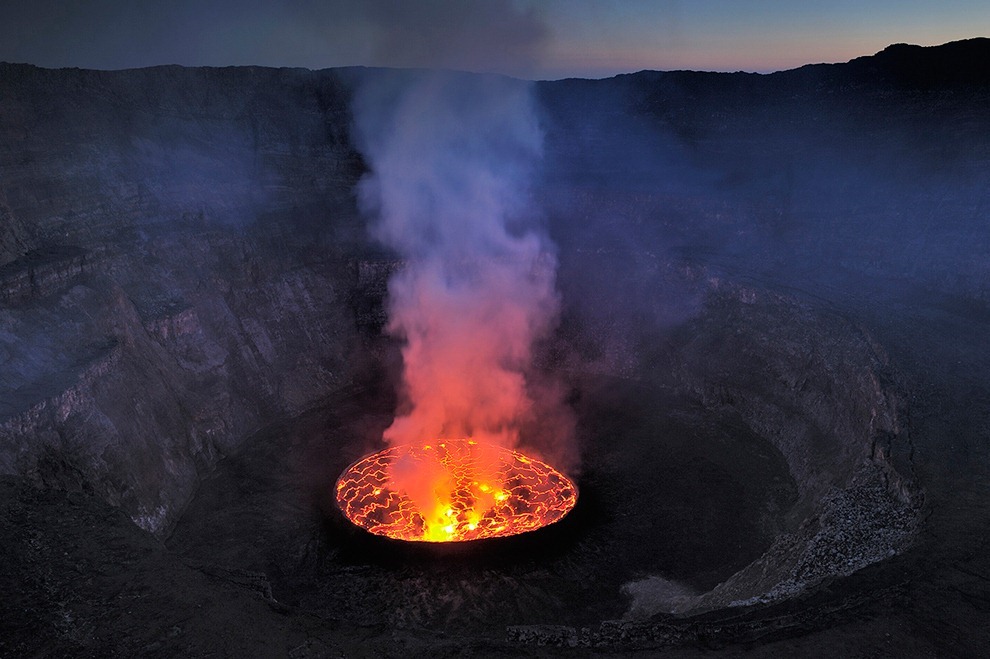Most volcanoes have a deep inner chamber of molten rocks, but this chamber is typically capped shut by cooled, solid rock. But sometimes the magma chamber is exposed at the top of the volcano in a giant caldera of rolling, bubbling and spluttering lava. This happens when an active volcano continuously pushes new molten rocks up the vent to form a pool inside the caldera, while solidified lava sinks back into the depth to be re-melted. Volcanologists often describe lava lakes as “windows into the heart of volcanoes.”
“Persistant lava lakes are very rare, and require a delicate equilibrium between heat supply and heat loss,” says VolcanoDiscovery.com. “Heat supply is provided by rising magmatic gasses from the magma chamber through a liquid-filled conduit, and is counterbalanced by intense heat lost at the surface of the lava lake.”
The lava lake of Mount Nyiragongo. Photo credit: Olivier Grunewald/Boston.com
There are only a handful of persistent lava lakes in the world. The most famous lava lake is the one on Mount Nyiragongo, in the Democratic Republic of the Congo. The lake is about 1.2 km across, the largest in existence, and is about 600 meters deep.
It is not known when the lava lake formed, but the volcano has been erupting since 1882. The volcano is infamous for its extremely fluid lava that may race downhill at up to 100 km/hr when the lava lake drains. On 10 January 1977, the crater walls fractured, and the lava lake drained in less than an hour overwhelming villages and killing at least 70 people. Another major eruption occurred in 2002. Fortunately, warnings had been given and 400,000 people were evacuated. Still 147 people died from asphyxiation and buildings collapsing.
The lava lake of Mount Nyiragongo. Photo credit: Cai Tjeenk Willink/Wikimedia

The lava lake of Mount Nyiragongo. Photo credit: Olivier Grunewald/Boston.com
The lava lake of Mount Nyiragongo. Photo credit: Olivier Grunewald/Boston.com
The lava lake of Mount Nyiragongo. Photo credit: Olivier Grunewald/Boston.com
Africa’s other lava lake is on Erta Ale, an active basaltic shield volcano in the Afar Region of northeastern Ethiopia. Erta Ale is only 613 meters high, but the elongated caldera is 1.7 km long. Within this caldera are numerous lava flows and several larger and smaller pit craters. One of these craters, sometimes two, contains lava lakes. The lava lake is known to exist since the 1960s
The lava lake of Erta Ale. Photo credit: Indrik myneur/Flickr
The lava lake of Erta Ale. Photo credit: filippo_jean/Flickr
The lava lake of Erta Ale. Photo credit: Raul Soler/Flickr
The lava lake of Erta Ale. Photo credit: V/Flickr
The lava lake of Erta Ale. Photo credit: filippo_jean/Wikimedia
The Ambrym volcano, in the archipelago of Vanuatu, some 1,750 kilometers east of northern Australia, contains lava lakes in two craters near the summit. The caldera is 12 km wide and is believed to have formed about 1,900 years ago. There are two vents in the caldera that have become large complex craters called Marum and Benbow. Both contains small lava lakes, which occasionally erupt lava flows onto the caldera floor.
The lava lake on Marum crater. Photo credit: Geophile71/Wikimedia
The lava lake of Ambrym volcano. Photo credit: Gus MacLeod/Flickr
Mount Erebus is located on Ross Island, and is the second highest volcano in Antarctica and the southernmost active volcano on earth. The caldera on the summit of Mount Erebus is elliptical having diameters of 500 meters and 600 meters. It contains an active lava lake within a second caldera that is 250 meters wide and 100 meters deep. The lava lake is connected to a long-lived, open and stable magma plumbing system, which might have been in place for the past 17,000 years. The lava lake itself has existed since 1972.
The lava lake of Mount Erebus. Photo credit: Carsten Peter
Kilauea is the youngest and most active of Hawaiian shield volcano, located on the southern part of the Island of Hawai'i, known as Big Island. Kilauea has two persistent lava lakes: one in the Halemaʻumaʻu vent cavity within the summit caldera, and another within the Puʻu ʻŌʻō cone located on the east rift zone of the volcano.
The lava lake in Puʻu ʻŌʻō crater. Photo credit: J.D. Griggs/Wikimedia
The Kilauea lava lake. Photo credit: U.S. Geological Survey/Flickr


























Comments
Post a Comment